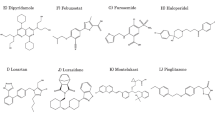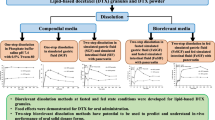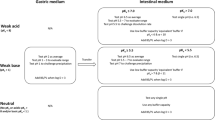Abstract
The objective of this work is to develop a biorelevant dissolution method to support the clinical study for In Vitro In Vivo Correlation (IVIVC) of the first commercially approved single-layer extrudable core system (ECS) osmotic tablet — the 11 mg tofacitinib modified-release tablet. The dissolution conditions were selected through analysis of experimental work including several designed experiments (DoE). The Apparatus 2 (paddles) was selected over the Apparatus 1 (baskets) to minimize the dissolution test variability. The paddle speed was kept at 50 rpm to be conservative and because higher paddle speed did not offer statistically significant improvement in dissolution test variability. The buffer of 50 mM potassium phosphate at pH 6.8 was selected over other buffers at lower or acid pH as the in vivo drug release is expected to occur in the small intestinal region, where the pH is approximately neutral. Finally, the statistically designed experiments proved that use of the Japanese basket sinkers was effective in reducing dissolution variability and eliminating the artificial shift in dissolution profile caused by final pink color-coated tablets sticking to the dissolution vessel. Discriminatory power of the method was verified and the method was validated per ICH and FDA guidelines. Since a Level A IVIVC is established from the analysis of the results of both in vivo clinical study and in vitro dissolution testing, the method is proven to be biorelevant. It also serves a suitable quality control dissolution method.
Graphical abstract







Similar content being viewed by others
Abbreviations
- ECS:
-
Extrudable Core System
- DoE:
-
Design of Experiments
- IVIVC:
-
In Vitro/In Vivo Correlation
- BE:
-
Bioequivalence
References
Dressman J, Krämer J. Pharmaceutical Dissolution Testing. 2nd ed. Atlanta: Taylor & Francis; 2005.
Wang Q, Fotaki N, Mao Y. Biorelevant Dissolution: Methodology and Application in Drug Development. Dissolut Technol. 2009;8:6–12.
Roudier B, et al. In Vitro- in vivo correlation’s dissolution limits setting. Pharm Res. 2014;31(9):2529–38.
Shah VP. The Role of Dissolution Testing in the Regulation of Pharmaceuticals, in Pharmaceutical Dissolution Testing, J. Dressman and J. Krämer, Editors. 2005, Taylors & Francis. p. 81–96.
Krämer J, Steinmetz R, and Stippler E. Dissolution Method Development with a View to Quality Control, in Pharmaceutical Dissolution Testing, J. Dressman and J. Krämer, Editors. 2005, Taylor & Francis. p. 315–350.
Waterman KC, MacDonald BC, Roy MC. Extrudable core system: development of a single-layer osmotic controlled-release tablet. J Control Release. 2009;134(3):201–6.
Thombre AG, et al. Osmotic drug delivery using swellable-core technology. J Control Release. 2004;94(1):75–89.
Malaterre V, Ogorka J, Loggia N, Gurny R. Oral osmotically driven systems: 30 years of development and clinical use. Eur J Pharm Biopharm. 2009;73:311–23.
Myers R and Montgomery D. Response Surface Methodology, Process and Product Optimization Using Designed Experiments. 1995, New York: Wiley.
Brown WE. Compendial Requirements of dissolution Testing - European Pharmacopoeia, Japanese Pharmacopoeia, United States Pharmacopeia, in Pharmaceutical Dissolution Testing, J. Dressman and J. Krämer, Editors. 2005, Taylor & Francis. p. 69–80.
Guidance for Industry Dissolution Testing of Immediate Release Solid Oral Dosage Forms. 1997, Rockville: U.S. Department of Health and Human Services Food and Drug Administration.
Guidance for Industry Bioavailability and Bioequivalence Studies Submitted in NDAs or INDs – General Considerations. 2014, Silver Spring: U.S. Department of Health and Human Services Food and Drug Administration.
Guidance for Industry Extended Release Oral Dosage Forms: Development, Evaluation, and Application of In Vitro/In Vivo Correlations. 1997, Rockville: U.S. Department of Health and Human Services Food and Drug Administration.
General Chapters: <711> Dissolution The United States Pharmacopeia. 2016, Rockville: United States Pharmacopeial Convention.
General Chapter 〈1092〉 The Dissolution Procedure: Development and Validation The United States Pharmacopeia. 2016, Rockville: United States Pharmacopeial Convention.
International Conference on Harmonization, Harmonized Tripartite Guideline, Validation of Analytical Procedures, Text and Methodology, Q2(R1). 2005, International Conference on Harmonization.
Lamba M, Wang R, Fletcher T, Alvey C, Kushner J, Stock T. Extended-release once-daily formulation of tofacitinib: evaluation of pharmacokinetics compared with immediate-release tofacitinib and impact of food. J Clin Pharmcol. 2016;56:1362–71.
Kushner J, Lamba M, Stock T, Wang R, Nemeth MA, Alvey C, Chen R, DeMatteo V and Blanchard A. “Development and validation of a level A in-vitro in-vivo correlation for tofacitinib extended release tablets using extrudable core system osmotic delivery technology”. Eur J Pharm Sci. 2020;147:105200.
Acknowledgements
The authors wish to thank the following Pfizer colleagues for their helpful discussions: Ling Zhang, Alfred Berchielli and John Larmann.
Funding
The work was funded by Pfizer Inc.
Author information
Authors and Affiliations
Contributions
All authors contributed to the study conception and design. Material preparation and data collection were performed by Vincent DeMatteo and Andrew Blanchard. The statistical analysis was performed by Jia Liu and Brent Harrington. The first draft of the manuscript was written by Raymond Chen and all authors commented on previous versions of the manuscript. All authors read and approved the final manuscript.
Corresponding author
Ethics declarations
Conflict of Interest
The authors are employees of Pfizer Inc. and own stocks of Pfizer Inc.
Additional information
Publisher's Note
Springer Nature remains neutral with regard to jurisdictional claims in published maps and institutional affiliations.
Supplementary Information
Below is the link to the electronic supplementary material.
Rights and permissions
About this article
Cite this article
Chen, R., Blanchard, A., Kushner, J. et al. Developing a Biorelevant Dissolution Method for an Extrudable Core System (ECS) Osmotic Tablet. AAPS PharmSciTech 23, 5 (2022). https://doi.org/10.1208/s12249-021-02110-x
Received:
Accepted:
Published:
DOI: https://doi.org/10.1208/s12249-021-02110-x




